17th Century William and Mary Kingwood Strongbox, with Gilt Brass
SOLD
Request Information
Follow Us
17th Century William and Mary Kingwood Strongbox, with Gilt Brass
A 17th century William and Mary Kingwood strongbox, with gilt brass straps. This strongbox has to be one of the most charming and certainly the smallest example we have encountered, at just 17.5 cm high, 28 cm wide and 18 cm deep. A strongbox of similar merit form and style resides at Burghley House in ‘The 1st George State Room.
The box appears decorative, but it was also very difficult to break open or steal. It has a strong lock to the centre and two bolts concealed in the sides, so that it could be screwed down into floorboards if necessary or that of a horse-drawn carriage. Strong-boxes veneered in oysters of Princewood such as this were luxury objects.
The Cabinet-makers who would have constructed and veneered the carcase apparently sold them, often using tropical hardwood veneers, and mounted it with sets of mounts, handles and locks bought in from brass founders. The elaborate veneering and conspicuous gilded brass mounts show that the appearance of these objects was important.
Thomas Pistor, of Ludgate Hill, London worked with the renowned cabinetmaker Gerrit Jensen. Gerrit Jensen supplied a walnut-veneered ‘strongbox’ to Colonel James Grahame in 1668, Levens Hall. It is recorded that Thomas Pistor’s remaining stock was sold off post his death in 1711, included ‘three fine Prices wood strongboxes’.
Condition
Fabulous original condition with a wonderful patina.
Provenance
Literature
Dimensions
PREVIOUSLY SOLD
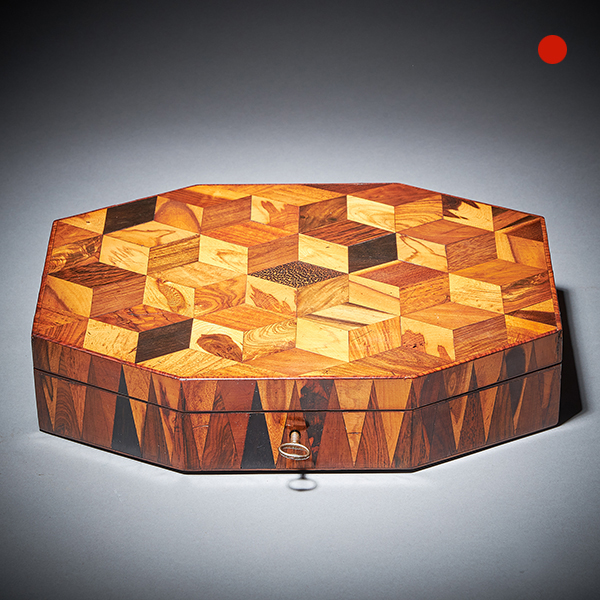
George IV Regency Exotic Wood Specimen Parquetry Games Box or Jewellery Box
George IV Regency Exotic Wood Specimen Parquetry Games or Jewellery Box SoldFollow UsGeorge IV Regency Exotic Wood Specimen Parquetry Games or Jewellery Box An extremely rare and fine example, decorated to all surfaces with exotic timbers....
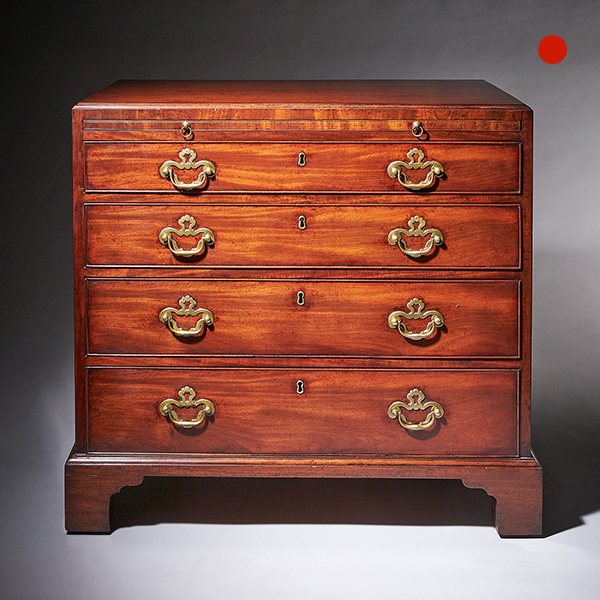
18th Century George II Mahogany Caddy-Topped Chest by Giles Grendey C.1730-1740
18th Century George II Mahogany Caddy-Topped Chest by Giles Grendey, C.1730-1740 Sold Follow Us18th Century George II Mahogany Caddy-Topped Chest by Giles Grendey, C.1730-1740 An important George II mahogany caddy-topped chest, circa...
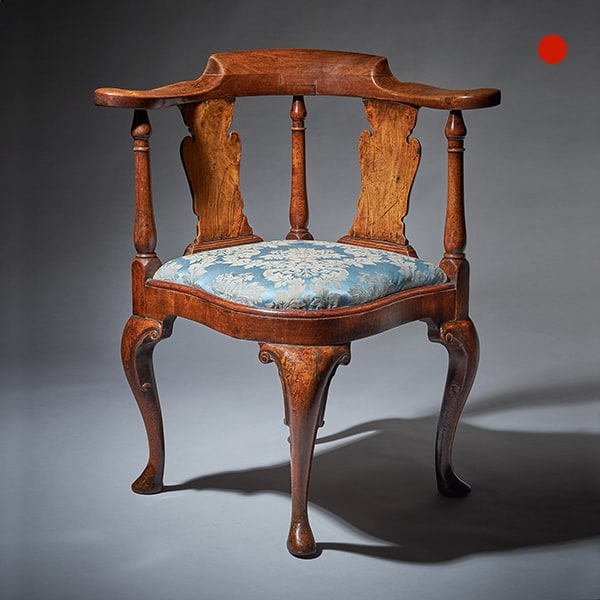
Queen Anne Period Walnut Corner Chair Circa 1702-1714
Queen Anne Period Walnut Corner Chair, Circa 1702-1714 Sold Follow UsQueen Anne Period Walnut Corner Chair, Circa 1702-1714 Queen Anne period walnut corner chair, 1702-1714. It is solid walnut, raised on four boldly carved cabriole legs with...
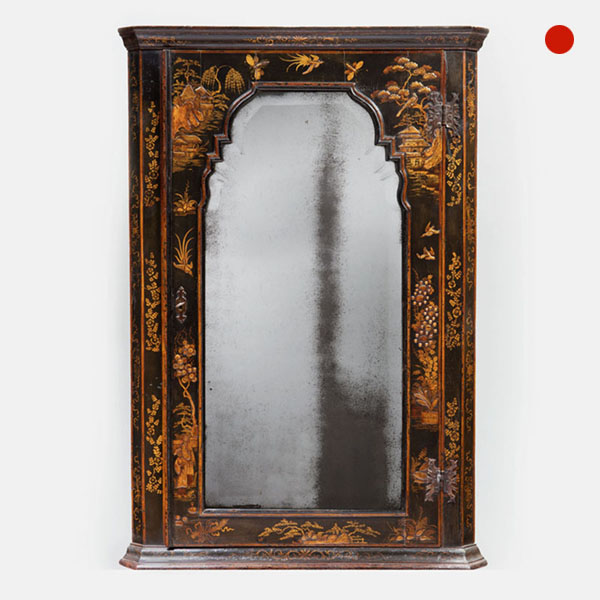
Important Queen Anne Japanned Chinoiserie Corner Cupboard by John Coxed
JOHN COXED Also known as COXED & WOSTER (worked c.1700-c.1718) Important Queen Anne Japanned Chinoiserie Corner Cupboard by John Coxed 1711-1715 England Sold Follow UsImportant Queen Anne Japanned Chinoiserie Corner Cupboard by John Coxed...
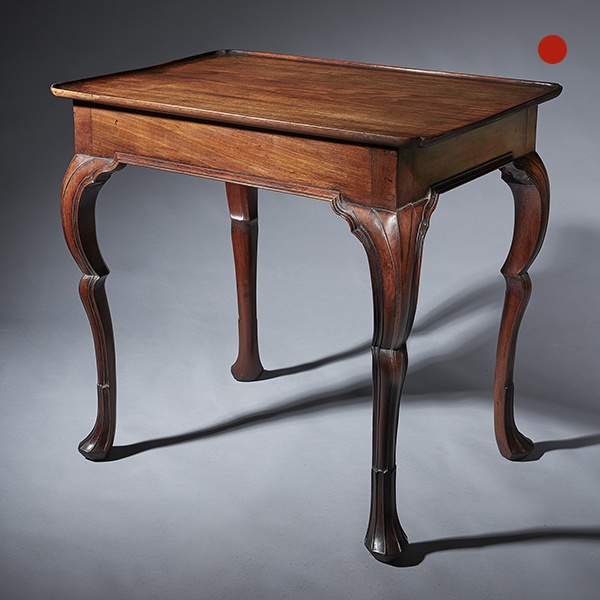
Important 18th Century Mahogany Irish Silver Table or Tea Table, circa 1740-1760
Important 18th Century Mahogany Irish Silver or Tea Table, circa 1740-1760 Sold Follow UsImportant 18th Century Mahogany Irish Silver or Tea Table, circa 1740-1760 An important early 18th century Irish silver or tea table, circa 1740-1750. The...

17th Century William and Mary Period Kingwood Oyster Strongbox or Coffre Fort
17th Century William and Mary Period Kingwood Oyster Strongbox or Coffre Fort SoldFollow Us17th Century William and Mary Period Kingwood Oyster Strongbox or Coffre Fort A fine large and rare kingwood oyster strongbox or Coffre Fort, circa...

George IV Regency Exotic Wood Specimen Parquetry Games Box or Jewellery Box
George IV Regency Exotic Wood Specimen Parquetry Games or Jewellery Box SoldFollow UsGeorge IV Regency Exotic Wood Specimen Parquetry Games or Jewellery Box An extremely rare and fine example, decorated to all surfaces with exotic timbers....

18th Century George II Mahogany Caddy-Topped Chest by Giles Grendey C.1730-1740
18th Century George II Mahogany Caddy-Topped Chest by Giles Grendey, C.1730-1740 Sold Follow Us18th Century George II Mahogany Caddy-Topped Chest by Giles Grendey, C.1730-1740 An important George II mahogany caddy-topped chest, circa...

Queen Anne Period Walnut Corner Chair Circa 1702-1714
Queen Anne Period Walnut Corner Chair, Circa 1702-1714 Sold Follow UsQueen Anne Period Walnut Corner Chair, Circa 1702-1714 Queen Anne period walnut corner chair, 1702-1714. It is solid walnut, raised on four boldly carved cabriole legs with...

Important Queen Anne Japanned Chinoiserie Corner Cupboard by John Coxed
JOHN COXED Also known as COXED & WOSTER (worked c.1700-c.1718) Important Queen Anne Japanned Chinoiserie Corner Cupboard by John Coxed 1711-1715 England Sold Follow UsImportant Queen Anne Japanned Chinoiserie Corner Cupboard by John Coxed...

Important 18th Century Mahogany Irish Silver Table or Tea Table, circa 1740-1760
Important 18th Century Mahogany Irish Silver or Tea Table, circa 1740-1760 Sold Follow UsImportant 18th Century Mahogany Irish Silver or Tea Table, circa 1740-1760 An important early 18th century Irish silver or tea table, circa 1740-1750. The...

17th Century William and Mary Period Kingwood Oyster Strongbox or Coffre Fort
17th Century William and Mary Period Kingwood Oyster Strongbox or Coffre Fort SoldFollow Us17th Century William and Mary Period Kingwood Oyster Strongbox or Coffre Fort A fine large and rare kingwood oyster strongbox or Coffre Fort, circa...
YOU MAY ALSO LIKE
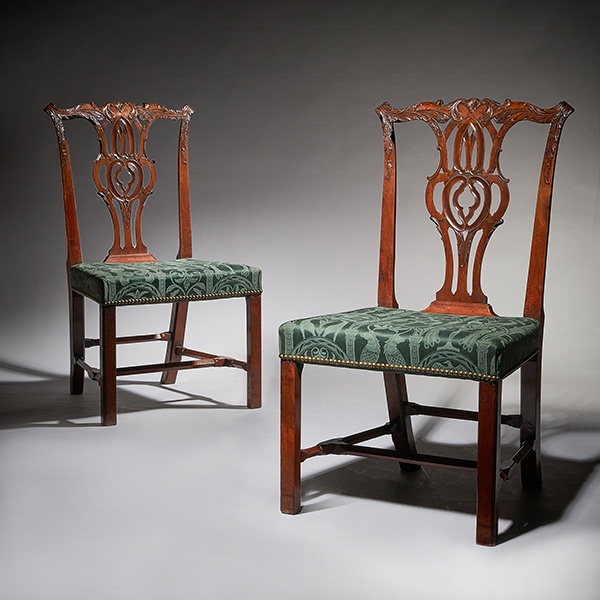
Pair of 18th Century George III Carved Mahogany Chippendale Chairs
Pair of 18th Century George III Carved Mahogany Chippendale Chairs £8,900Follow UsPair of 18th Century George III Carved Mahogany Chippendale Chairs A simply superb pair of carved George III mahogany chairs, C.1770. Condition Good. Wear...
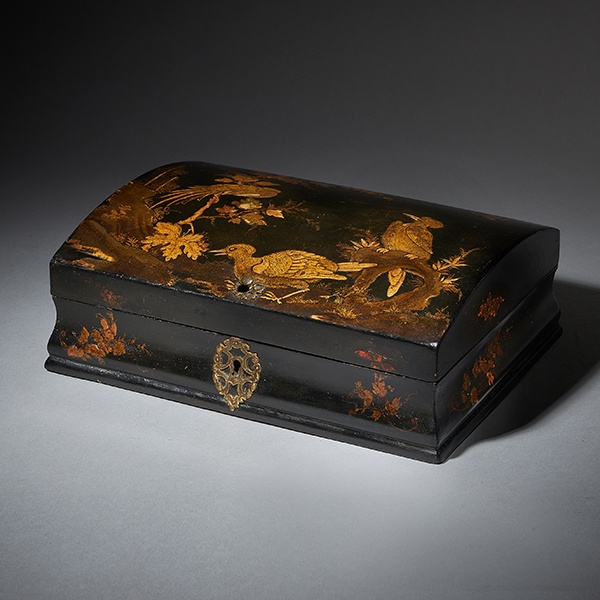
18th Century Japanned Chinoiserie Dome-Topped Box, Circa 1715-1725
18th Century Japanned Chinoiserie Dome-Topped Box, Circa 1715-1725 £3,800Follow Us18th Century Japanned Chinoiserie Dome-Topped Box, Circa 1715-1725 Early 18th century George I Japanned Chinoiserie dome-topped box, Circa 1715-1725. England or...
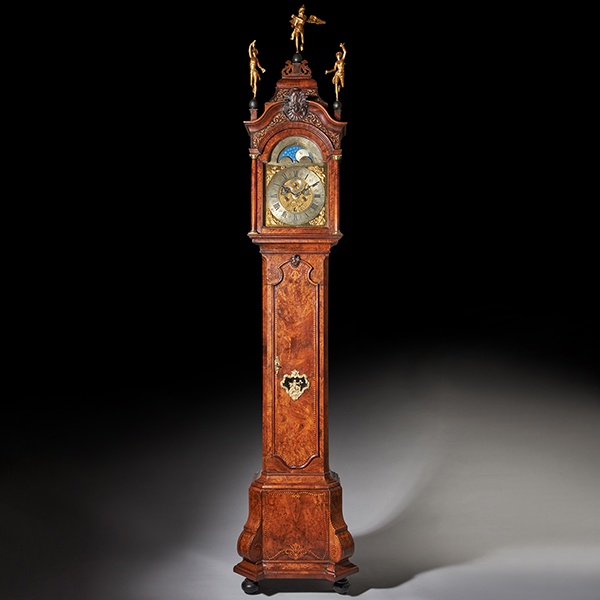
Magnificent 18th Century Striking Dutch Amsterdam Burl Walnut Longcase Clock
Magnificent 18th Century Striking Dutch Amsterdam Burl Walnut Longcase Clock £26,000Follow UsMagnificent 18th Century Striking Dutch Amsterdam Burl Walnut Longcase Clock An impressive Dutch longcase clock with a burr walnut veneered oak case,...
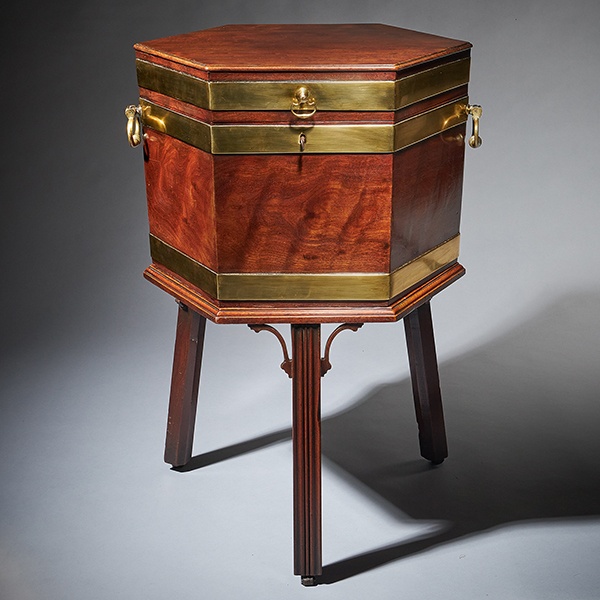
18th Century George III Mahogany Wine Cooler or Cellarette
18th Century George III Mahogany Wine Cooler or Cellarette £4,600Follow Us18th Century George III Mahogany Wine Cooler or Cellarette A fine and well-figured George III mahogany hexagonal wine cooler or cellarette on the original stand, C....

Striking 19th Century Carriage Clock with a Gilt-Brass Corniche Case by Grohé
Striking 19th Century Carriage Clock with a Gilt-Brass Corniche Case by Grohé £3,995 Follow UsStriking 19th Century Carriage Clock with a Gilt-Brass Corniche Case by Grohé Striking carriage clock with a gilt-brass corniche case by Grohé,...
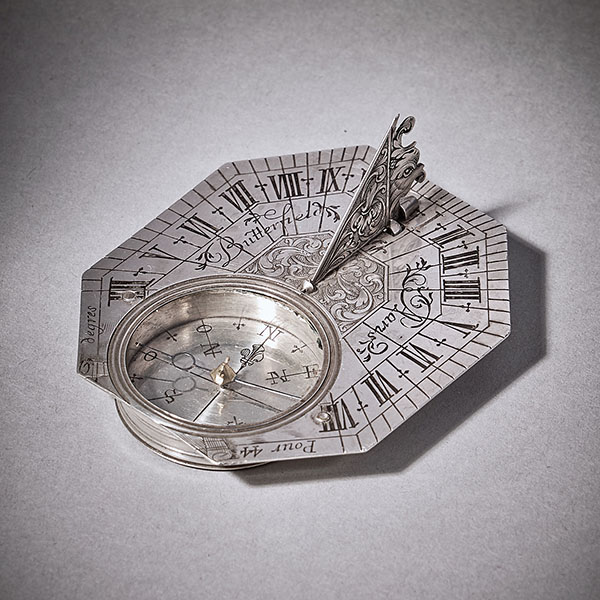
Rare Silver Pocket Sundial and Compass by Michael Butterfield, Paris, circa 1700
Rare Silver Pocket Sundial and Compass by Michael Butterfield, Paris, circa 1700 £4,900 Follow UsRare Silver Pocket Sundial and Compass by Michael Butterfield, Paris, circa 1700 A beautiful, rare solid silver Anglo-French octagonal pocket...

Pair of 18th Century George III Carved Mahogany Chippendale Chairs
Pair of 18th Century George III Carved Mahogany Chippendale Chairs £8,900Follow UsPair of 18th Century George III Carved Mahogany Chippendale Chairs A simply superb pair of carved George III mahogany chairs, C.1770. Condition Good. Wear...

18th Century Japanned Chinoiserie Dome-Topped Box, Circa 1715-1725
18th Century Japanned Chinoiserie Dome-Topped Box, Circa 1715-1725 £3,800Follow Us18th Century Japanned Chinoiserie Dome-Topped Box, Circa 1715-1725 Early 18th century George I Japanned Chinoiserie dome-topped box, Circa 1715-1725. England or...

Magnificent 18th Century Striking Dutch Amsterdam Burl Walnut Longcase Clock
Magnificent 18th Century Striking Dutch Amsterdam Burl Walnut Longcase Clock £26,000Follow UsMagnificent 18th Century Striking Dutch Amsterdam Burl Walnut Longcase Clock An impressive Dutch longcase clock with a burr walnut veneered oak case,...

18th Century George III Mahogany Wine Cooler or Cellarette
18th Century George III Mahogany Wine Cooler or Cellarette £4,600Follow Us18th Century George III Mahogany Wine Cooler or Cellarette A fine and well-figured George III mahogany hexagonal wine cooler or cellarette on the original stand, C....

Striking 19th Century Carriage Clock with a Gilt-Brass Corniche Case by Grohé
Striking 19th Century Carriage Clock with a Gilt-Brass Corniche Case by Grohé £3,995 Follow UsStriking 19th Century Carriage Clock with a Gilt-Brass Corniche Case by Grohé Striking carriage clock with a gilt-brass corniche case by Grohé,...

Rare Silver Pocket Sundial and Compass by Michael Butterfield, Paris, circa 1700
Rare Silver Pocket Sundial and Compass by Michael Butterfield, Paris, circa 1700 £4,900 Follow UsRare Silver Pocket Sundial and Compass by Michael Butterfield, Paris, circa 1700 A beautiful, rare solid silver Anglo-French octagonal pocket...









